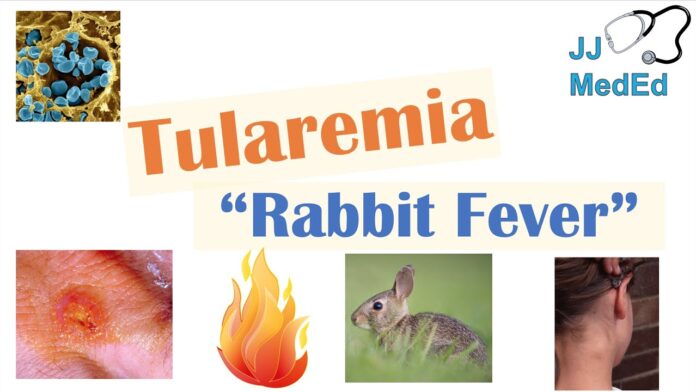TULAREMIA IN RABBIT
Tularemia is an infectious disease caused by the bacterium Francisella tularensis. It affects both humans and animals, and is typically found in wild animals such as rabbits, muskrats, and beavers. It is also known as Rabbit Fever because hunters can get the disease from contact with infected rabbits. There is concern that Francisella tularensis could be used as a bioterrorist agent.
How Is Tularemia Spread?
Hunters and other people who spend a lot of time outdoors are at greater risk of being exposed to tularemia. Tularemia is contracted through the following routes:
- Skin: The most common route is through a cut in the skin while handling infected animals, or by being bitten by an infected tick or deerfly.
- Stomach: Eating an infected animal such as a rabbit, or less commonly through drinking contaminated water.
- Lungs: The bacteria can be inhaled after breathing in dust from contaminated soil. Airborne tularemia would be the most likely agent for a bioterrorist attack as it could be released through aerosol spray devices.
Tularemia is not known to be spread from person to person.
Frequently Asked Questions (FAQ) About Tularemia
- What is tularemia?
A. Tularemia, also known as “rabbit fever,” is a disease caused by the bacterium Francisella tularensis. Tularemia is typically found in animals, especially rodents, rabbits, and hares. Tularemia is usually a rural disease and has been reported in all U.S. states except Hawaii. - How do people become infected with tularemia?
A. Typically, people become infected through the bite of infected insects (most commonly, ticks and deerflies), by handling infected sick or dead animals, by eating or drinking contaminated food or water, or by inhaling airborne bacteria. - Does tularemia occur naturally in the United States?
A. Yes. Tularemia is a widespread disease in animals. About 200 human cases of tularemia are reported each year in the United States. Most cases occur in the south-central and western states. Nearly all cases occur in rural areas, and are caused by the bites of ticks and biting flies or from handling infected rodents, rabbits, or hares. Cases also resulted from inhaling airborne bacteria and from laboratory accidents. - What are the signs and symptoms of tularemia?
A. The signs and symptoms people develop depend on how they are exposed to tularemia. Possible symptoms include skin ulcers, swollen and painful lymph glands, inflamed eyes, sore throat, mouth sores, diarrhea or pneumonia. If the bacteria are inhaled, symptoms can include abrupt onset of fever, chills, headache, muscle aches, joint pain, dry cough, and progressive weakness. People with pneumonia can develop chest pain, difficulty breathing, bloody sputum, and respiratory failure. Tularemia can be fatal if the person is not treated with appropriate antibiotics. - Why are we concerned about tularemia being used as a bioweapon?
A. Francisella tularensisis highly infectious. A small number of bacteria (10-50 organisms) can cause disease. If Francisella tularensiswere used as a bioweapon, the bacteria would likely be made airborne so they could be inhaled. People who inhale the bacteria can experience severe respiratory illness, including life-threatening pneumonia and systemic infection, if they are not treated. - Can someone become infected with the tularemia bacteria from another person?
A. People have not been known to transmit the infection to others, so infected persons do not need to be isolated. - How quickly would someone become sick if he or she were exposed to tularemia bacteria?
A. The incubation period (the time from being exposed to becoming ill) for tularemia is typically 3 to 5 days, but can range from 1 to 14 days. - What should someone do if he or she suspects exposure to tularemia bacteria?
A. If you suspect you were exposed to tularemia bacteria, see a doctor quickly. Treatment with antibiotics for a period of 10-14 days or more after exposure may be recommended. If you are given antibiotics, it is important to take them according to the instructions you receive. All of the medication you are given must be taken.
Local and state health departments should be notified immediately so an investigation and infection control activities can begin.
- How is tularemia diagnosed?
A. When a person has symptoms that appear related to tularemia, the healthcare worker collects specimens, such as blood or sputum, for testing in a diagnostic or reference laboratory. Laboratory test results for tularemia may be presumptive or confirmatory. Presumptive (preliminary) identification may take less than 2 hours, but confirmatory testing will take more time, often 24 to 48 hours or longer depending on the methods that need to be used.
Depending on the circumstances, a person may be given treatment based on symptoms before the laboratory results are returned.
- Can tularemia be effectively treated with antibiotics?
A. Yes. Early antibiotic treatment is recommended whenever it is likely a person was exposed to tularemia or has been diagnosed as being infected with tularemia. Several types of antibiotics have been effective in treating tularemia infections. The tetracycline class (such as doxycycline) or fluoroquinolone class (such as ciprofloxacin) of antibiotics are taken orally. Streptomycin or gentamicin are also effective against tularemia, and are given by injection into a muscle or vein. Health officials will test the bacteria in the early stages of the response to determine which antibiotics will be most effective. - How long can Francisella tularensisexist in the environment?
A. Francisella tularensiscan remain alive for weeks in water and soil.
Is there a vaccine available for tularemia?
A. A vaccine for tularemia was used in the past to protect laboratory workers, but it is not currently available.
Compiled & Shared by- Team, LITD (Livestock Institute of Training & Development)
Image-Courtesy-Google
Reference-On Request



